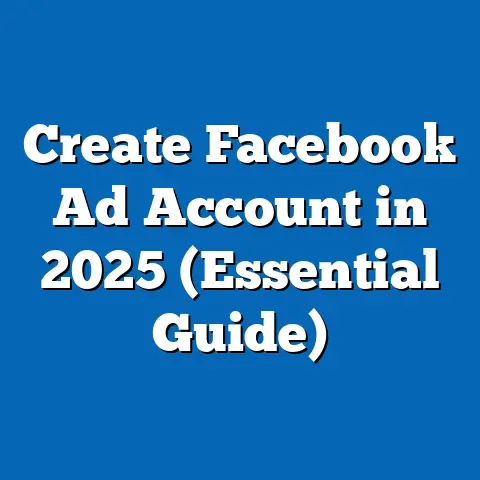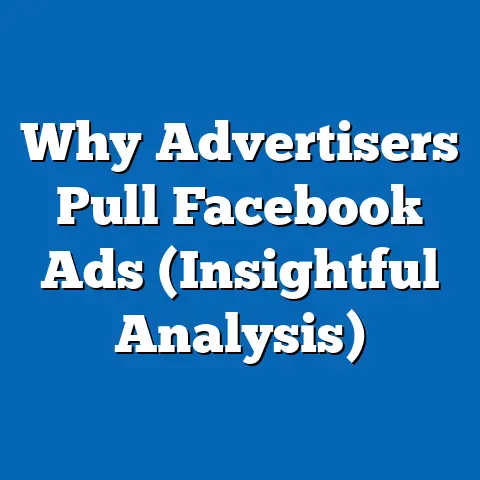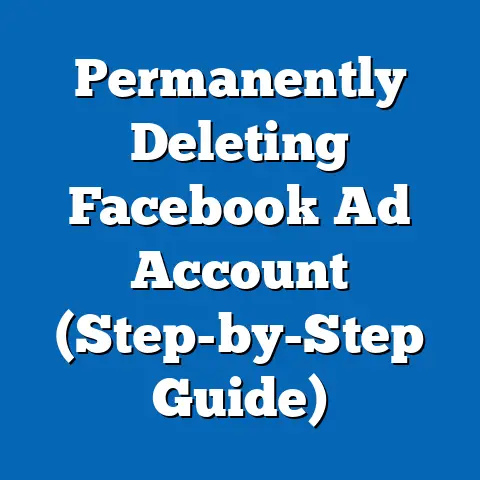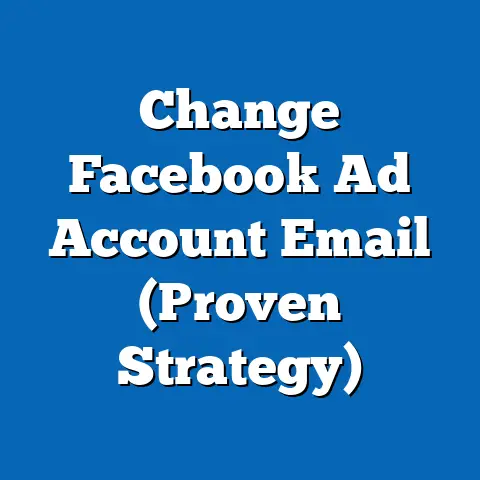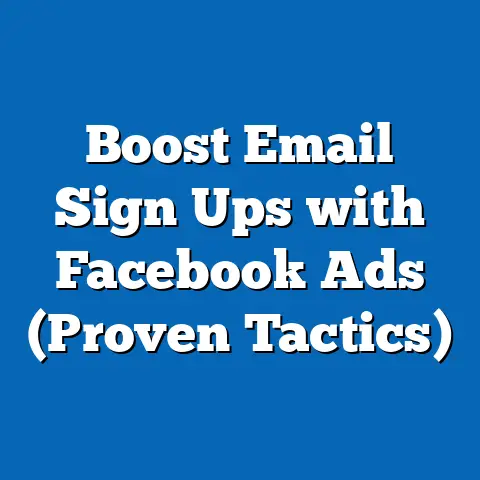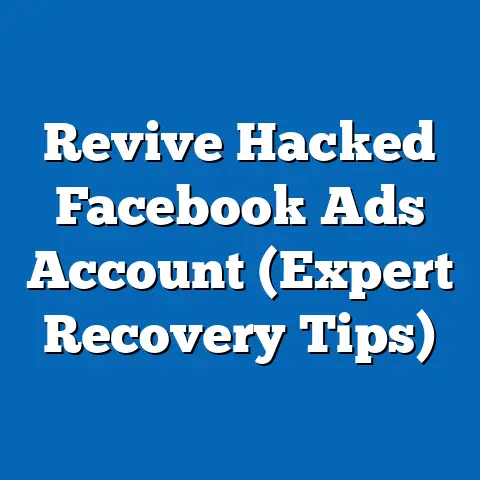Unlocking Facebook Ad Visibility (Expert Strategy Inside)
Have you ever felt like you’re throwing money into a black hole with your Facebook ads? In a digital world overflowing with content, how can your Facebook ads rise above the noise and be seen by the right audience? I’ve been there, staring at lackluster results and wondering where I went wrong. The truth is, achieving optimal visibility on Facebook isn’t about luck; it’s about understanding the platform, mastering its tools, and continuously adapting to its ever-changing landscape. This guide is designed to arm you with the expert strategies you need to unlock the true potential of your Facebook ad campaigns.
Understanding Facebook’s Advertising Ecosystem
Before diving into specific strategies, it’s crucial to grasp the fundamentals of Facebook’s advertising ecosystem. Think of it as a vast, intricate garden where millions of advertisers are vying for the attention of billions of users.
Overview of Facebook Ads
Facebook is a powerhouse in the advertising world, boasting billions of active users. This massive reach makes it an incredibly attractive platform for businesses of all sizes. But it’s not just about the sheer number of users; it’s about the granularity of targeting. Facebook allows you to pinpoint your ideal customer with remarkable precision, based on demographics, interests, behaviors, and more.
The platform offers a variety of ad formats to suit different objectives. Here are a few common examples:
- Image Ads: These are simple yet effective, using a single image to capture attention. They’re great for showcasing products or building brand awareness.
- Video Ads: Video is king in the digital age, and Facebook video ads are no exception. They’re highly engaging and can be used to tell stories, demonstrate products, or share testimonials.
- Carousel Ads: These ads allow you to display multiple images or videos in a single ad unit, each with its own headline, description, and link. They’re perfect for showcasing a range of products or features.
- Collection Ads: Designed for e-commerce businesses, collection ads display a main video or image with related products below. They offer a seamless shopping experience directly within Facebook.
I remember when I first started with Facebook ads, I was overwhelmed by the sheer number of options. I wasted a lot of time and money experimenting with different formats before I realized the importance of aligning my ad format with my campaign objective. For example, if I’m trying to drive sales of a specific product, a carousel ad with multiple product images and direct links to my website is far more effective than a simple image ad.
The Algorithm Behind Visibility
Facebook’s algorithm is the gatekeeper that determines which ads are shown to which users. It’s a complex system that constantly evolves, making it challenging for advertisers to stay ahead of the curve. However, understanding the key factors that influence the algorithm is essential for maximizing ad visibility.
- Relevance Score: This is a metric that Facebook uses to assess the quality and relevance of your ad to your target audience. The higher your relevance score, the more likely your ad is to be shown and the lower your costs will be. Factors that influence relevance score include ad copy, creative quality, and targeting accuracy.
- Engagement Metrics: Facebook rewards ads that generate high levels of engagement, such as likes, comments, shares, and clicks. The more engagement your ad receives, the more likely it is to be shown to a wider audience.
- User Behavior: Facebook tracks user behavior on and off the platform to understand their interests and preferences. This data is used to personalize the ad experience and ensure that users are seeing ads that are relevant to them.
One of the biggest mistakes I see advertisers make is ignoring the relevance score. They focus solely on targeting the right audience and creating compelling ad copy, but they neglect the importance of relevance. Remember, Facebook wants to provide a positive user experience, so it will prioritize ads that are both relevant and engaging.
Key Takeaway: Understanding the Facebook advertising ecosystem, including the various ad formats and the algorithm that governs visibility, is the foundation for successful campaigns.
Importance of Targeting and Audience Segmentation
Targeting is the cornerstone of any successful Facebook ad campaign. It’s the process of identifying and reaching the specific group of people who are most likely to be interested in your product or service. Without effective targeting, your ads will be shown to the wrong people, resulting in wasted ad spend and poor results.
Defining Your Target Audience
Defining your target audience involves understanding their demographics, interests, behaviors, and pain points. This requires thorough research and a deep understanding of your ideal customer.
- Demographics: This includes factors such as age, gender, location, education, and income.
- Interests: This includes the topics, hobbies, and activities that your target audience is interested in.
- Behaviors: This includes the actions that your target audience takes on and off Facebook, such as their purchasing habits, online activities, and device usage.
- Custom Audiences: These are audiences that you create based on your existing customer data, such as email lists, website visitors, or app users.
When I’m defining my target audience, I like to create a detailed customer persona. This is a fictional representation of my ideal customer, including their demographics, interests, behaviors, pain points, and goals. This helps me to visualize my target audience and create ads that resonate with them on a personal level.
Utilizing Facebook’s Audience Insights Tool
Facebook’s Audience Insights tool is a powerful resource for gathering data about potential customers, creating audience segments, and refining targeting strategies. It provides valuable insights into the demographics, interests, and behaviors of your target audience, helping you to create more effective ad campaigns.
Here’s a step-by-step guide on how to use this tool:
- Access Audience Insights: Navigate to the Ads Manager and find the “Audience Insights” option in the “Tools” menu.
- Choose Your Audience: You can choose to analyze everyone on Facebook or people who are connected to your page. If you have a substantial following, starting with your page’s audience can be insightful.
- Explore Demographics: Review the age, gender, education level, relationship status, and job titles of your audience. This data helps you understand the basic characteristics of your potential customers.
- Uncover Interests: Discover the pages and topics your audience likes. This can reveal hidden interests that you can target in your ad campaigns.
- Analyze Behaviors: Understand the purchasing behaviors, device usage, and activities of your audience on Facebook. This can help you tailor your ad messaging and targeting.
- Create Audience Segments: Based on your findings, create specific audience segments that you can target with your ads. For example, you might create a segment of young professionals interested in fitness and healthy eating.
I once used the Audience Insights tool to discover that my target audience for a new fitness product was also highly interested in outdoor activities like hiking and camping. This insight allowed me to create ads that featured my product in outdoor settings, which significantly improved my click-through rates and conversions.
Key Takeaway: Effective targeting is crucial for maximizing ad visibility and ensuring that your ads are seen by the right people. Use Facebook’s Audience Insights tool to gather data, create audience segments, and refine your targeting strategies.
Crafting Compelling Ad Content
Even with perfect targeting, your ads will fall flat if the content isn’t compelling. Think of your ad as a tiny billboard competing for attention in a crowded marketplace. It needs to be visually appealing, attention-grabbing, and persuasive enough to make people stop scrolling and take action.
The Role of Creative Elements
Creative elements, including visuals, copy, and call-to-action buttons, play a critical role in ad effectiveness. They work together to capture attention, communicate your message, and drive conversions.
- Visuals: Use high-quality images or videos that are visually appealing and relevant to your target audience. Avoid using stock photos that look generic or staged. Instead, opt for authentic images that showcase your product or service in a natural and engaging way.
- Copy: Write clear, concise, and persuasive ad copy that highlights the benefits of your product or service. Focus on solving your target audience’s pain points and addressing their needs. Use strong verbs and active language to create a sense of urgency.
- Call-to-Action Buttons: Use clear and concise call-to-action buttons that tell people what you want them to do. Common call-to-action buttons include “Learn More,” “Shop Now,” “Sign Up,” and “Contact Us.”
I’ve learned that visuals are often the first thing people notice about an ad, so it’s crucial to make a strong first impression. I’ve experimented with different types of visuals, including lifestyle photos, product demos, and animated videos. I’ve found that videos tend to perform best, especially when they’re short, engaging, and optimized for mobile viewing.
A/B Testing for Optimization
A/B testing, also known as split testing, is the process of comparing two versions of an ad to determine which one performs better. It’s an essential tool for optimizing your ad content and maximizing your return on investment.
Here are some variables you can test:
- Headlines: Test different headlines to see which one grabs attention and generates the most clicks.
- Images: Test different images to see which one resonates best with your target audience.
- Ad Formats: Test different ad formats, such as image ads, video ads, and carousel ads, to see which one performs best for your objective.
- Call-to-Action Buttons: Test different call-to-action buttons to see which one drives the most conversions.
- Targeting Options: Test different targeting options to see which one reaches the most relevant audience.
When I’m A/B testing, I like to focus on testing one variable at a time. This allows me to isolate the impact of each variable and determine which one is driving the performance difference. For example, if I’m testing two different headlines, I’ll keep all other elements of the ad the same, such as the image, copy, and call-to-action button.
Key Takeaway: Compelling ad content is essential for capturing attention, communicating your message, and driving conversions. Use high-quality visuals, persuasive ad copy, and clear call-to-action buttons. A/B test your ads to identify what resonates best with your audience and optimize your performance.
Leveraging Advanced Facebook Ad Features
Facebook offers a range of advanced ad features that can help you reach a wider audience, re-engage existing customers, and improve your overall ad performance.
Retargeting Strategies
Retargeting is the process of showing ads to people who have previously interacted with your brand, such as website visitors, app users, or email subscribers. It’s a powerful way to re-engage people who are already familiar with your brand and increase your chances of driving conversions.
Here’s how to set up retargeting campaigns effectively:
- Install the Facebook Pixel: The Facebook Pixel is a small piece of code that you install on your website. It tracks the actions that people take on your website, such as visiting pages, adding items to their cart, and making purchases.
- Create Custom Audiences: Create custom audiences based on the actions that people have taken on your website. For example, you might create an audience of people who have visited your product pages but haven’t made a purchase.
- Create Retargeting Ads: Create retargeting ads that are specifically targeted to your custom audiences. For example, you might create an ad that offers a discount to people who have abandoned their cart.
I’ve found that retargeting campaigns are incredibly effective for driving sales and increasing customer loyalty. By showing ads to people who have already expressed interest in my brand, I can significantly increase my conversion rates and return on investment.
Lookalike Audiences
Lookalike audiences are audiences that Facebook creates based on your existing customer data. They’re designed to help you reach new customers who resemble your existing ones, based on their demographics, interests, and behaviors.
Here are some tips on how to create and utilize lookalike audiences:
- Start with a High-Quality Source Audience: Use a source audience that is representative of your ideal customer. This could be your email list, your website visitors, or your app users.
- Choose the Right Audience Size: Facebook allows you to choose the size of your lookalike audience, ranging from 1% to 10% of the total population in a given country. A smaller audience will be more similar to your source audience, while a larger audience will be less similar but will have a wider reach.
- Test Different Lookalike Audiences: Test different lookalike audiences based on different source audiences and audience sizes to see which one performs best for your objective.
I’ve used lookalike audiences to expand my reach and find new customers who are likely to be interested in my products. I’ve found that lookalike audiences based on my existing customer list tend to perform best, as they are the most similar to my ideal customer.
Key Takeaway: Leverage advanced Facebook ad features, such as retargeting and lookalike audiences, to reach a wider audience, re-engage existing customers, and improve your overall ad performance.
Monitoring and Analyzing Performance Metrics
Monitoring and analyzing your ad performance is crucial for understanding what’s working and what’s not. It allows you to make data-driven decisions and optimize your campaigns for maximum return on investment.
Key Performance Indicators (KPIs)
Key Performance Indicators (KPIs) are essential metrics for measuring ad visibility and success. These include:
- Impressions: The number of times your ad is shown to users.
- Reach: The number of unique users who have seen your ad.
- Click-Through Rate (CTR): The percentage of users who click on your ad after seeing it.
- Conversions: The number of users who take a desired action, such as making a purchase or filling out a form, after clicking on your ad.
- Cost Per Click (CPC): The average cost you pay each time someone clicks on your ad.
- Cost Per Conversion (CPC): The average cost you pay for each conversion.
- Return on Ad Spend (ROAS): The amount of revenue you generate for every dollar you spend on advertising.
I like to track these KPIs on a daily basis to identify any trends or anomalies. If I see a sudden drop in CTR, for example, I’ll investigate the issue and make adjustments to my ad copy or targeting.
Interpreting Facebook Ads Manager Data
Facebook Ads Manager provides a wealth of data about your ad performance. It can be overwhelming at first, but with a little practice, you can learn to navigate the platform and extract valuable insights.
Here are some tips on how to interpret Facebook Ads Manager data:
- Focus on the Metrics That Matter: Don’t get bogged down in irrelevant metrics. Focus on the KPIs that are most important to your business goals.
- Segment Your Data: Segment your data by demographics, interests, behaviors, and placement to identify which segments are performing best.
- Compare Your Results to Benchmarks: Compare your results to industry benchmarks to see how your ads are performing relative to your competitors.
- Use the Reporting Tools: Use the reporting tools in Facebook Ads Manager to create custom reports that track your key metrics over time.
I remember when I first started using Facebook Ads Manager, I was completely lost in the sea of data. It took me a while to figure out which metrics were most important and how to interpret them. But once I got the hang of it, I was able to use the data to make informed decisions and significantly improve my ad performance.
Key Takeaway: Monitoring and analyzing your ad performance is crucial for understanding what’s working and what’s not. Track your KPIs, interpret Facebook Ads Manager data, and make data-driven decisions to optimize your campaigns for maximum return on investment.
Staying Updated with Facebook’s Advertising Trends
The world of Facebook advertising is constantly evolving. New features are introduced, algorithms are updated, and best practices change. To stay ahead of the curve and maintain optimal ad visibility, it’s essential to stay informed about the latest trends and changes in the platform.
Adapting to Changes in the Platform
Facebook regularly updates its advertising platform with new features, targeting options, and ad formats. These updates can have a significant impact on ad visibility, so it’s important to stay informed and adapt your strategies accordingly.
Here are some ways to stay updated with changes in the platform:
- Follow the Facebook Business Blog: The Facebook Business Blog is a great resource for staying informed about the latest news and updates from Facebook.
- Attend Industry Events: Attend industry events and webinars to learn from experts and network with other advertisers.
- Join Online Communities: Join online communities and forums to connect with other advertisers and share tips and best practices.
I make it a point to read the Facebook Business Blog regularly and attend at least one industry event per year. This helps me to stay on top of the latest trends and changes in the platform and adapt my strategies accordingly.
Industry Trends and Best Practices
In addition to staying informed about changes in the platform, it’s also important to be aware of current industry trends and best practices. This includes things like the rise of video content, the increasing importance of mobile advertising, and the growing popularity of social commerce.
Here are some current trends in Facebook advertising:
- Video Content: Video is becoming increasingly popular on Facebook, and video ads are often more engaging than image ads.
- Mobile Advertising: Mobile devices account for a significant portion of Facebook’s ad revenue, so it’s important to optimize your ads for mobile viewing.
- Social Commerce: Social commerce is the practice of selling products directly through social media platforms. Facebook offers a range of social commerce features, such as Facebook Shops, that allow businesses to sell products directly to their customers.
Key Takeaway: Staying updated with Facebook’s advertising trends is crucial for maintaining optimal ad visibility. Adapt to changes in the platform, follow industry trends, and continuously experiment with new strategies to stay ahead of the curve.
Conclusion
Unlocking Facebook ad visibility is an ongoing journey that requires a deep understanding of the platform, a commitment to continuous learning, and a willingness to adapt to change. By mastering the strategies outlined in this guide, including understanding the Facebook advertising ecosystem, targeting the right audience, crafting compelling ad content, leveraging advanced features, monitoring performance, and staying updated with trends, you can significantly improve your ad visibility and achieve your business goals. Are you ready to take your Facebook advertising to the next level and unlock the true potential of your campaigns? The strategies are here; now it’s time to implement them and watch your ads rise above the noise.

